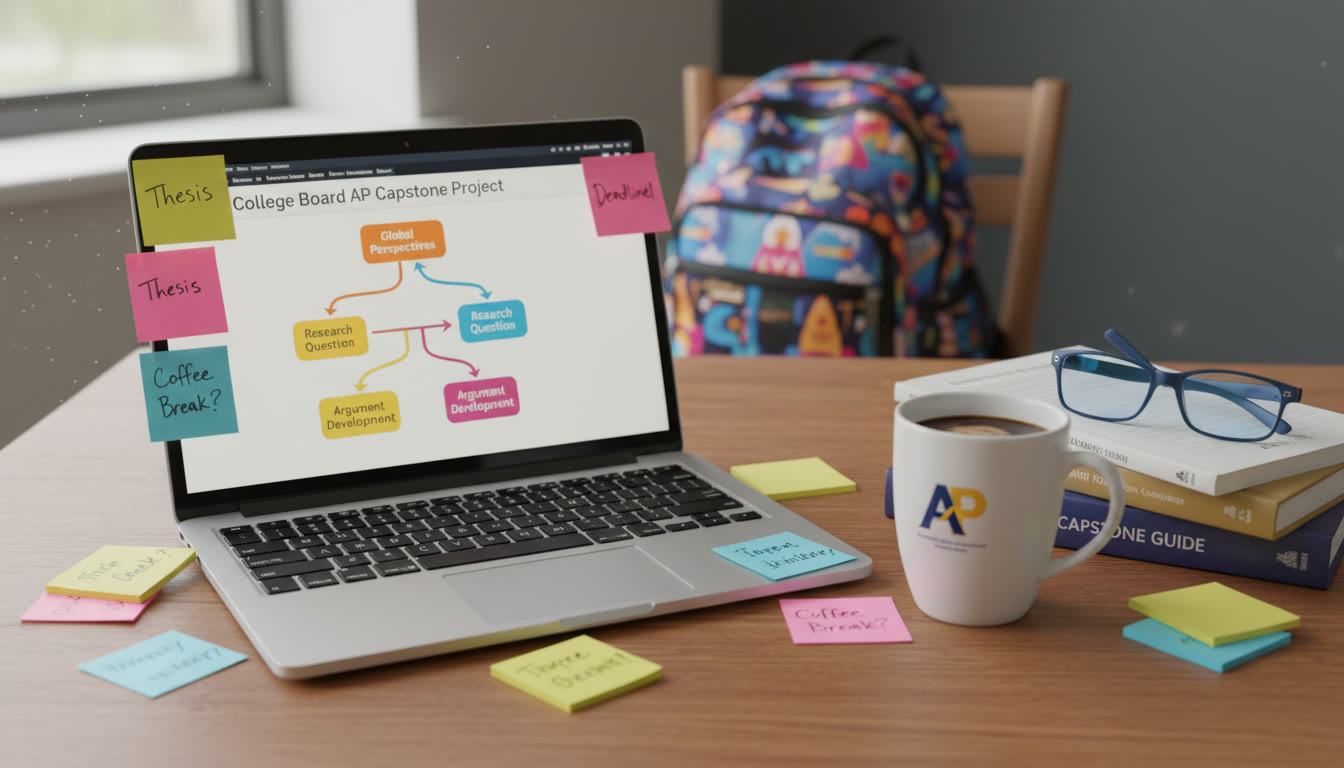Why Evidence Chains Matter: Turning Ideas Into Convincing Capstone Work
Every great capstone, independent study, or extended research project hinges on a clear, believable flow from what you assert to how you demonstrate it and how you qualify that demonstration. That flow is often called an evidence chain. In CAPSTONE contexts—especially AP Seminar and AP Research—your claim is only as strong as the method you used, the results you report, and the limitations you acknowledge. Treating these four elements as a connected chain turns scattered facts into persuasive scholarship.

What an evidence chain is (in plain English)
Think of an evidence chain like a recipe. The claim is the dish you promise to make. The method lists the ingredients and steps. The results are what arrives on the plate. Limitations are the dietary restrictions, burnt edges, or missing spices you admit to—things that mean your dish isn’t flawless but still informative. Together, these pieces allow readers (or examiners) to evaluate how credible your work is and whether they can trust your conclusions.
Claim: Start Strong, Stay Specific
The claim is your assertion—the central idea you want readers to accept. In capstone projects, especially those evaluated by AP standards, vague claims weaken your project. Aim for precise, testable, or investigable claims.
Characteristics of a solid claim
- Clear and concise: Avoid fuzzy language like “sort of” or “somewhat.”
- Falsifiable or at least clearly assessable: You should be able to gather evidence that supports or challenges it.
- Relevant to a community of interest: teachers, peers, stakeholders, or a discipline.
- Scoped appropriately: neither so broad it’s unmanageable nor so narrow it’s trivial.
Example claims (capstone-friendly):
- “Integrating weekly peer-led debriefs into AP Seminar sections improves students’ argumentative writing scores by increasing revision frequency.”
- “A community garden program increases neighborhood social cohesion as measured by participation rates and survey-reported trust.”
Method: The Engine of Your Chain
If the claim is the destination, the method is the route map. This section explains exactly how you collected and analyzed data. A transparent, well-reasoned method builds credibility—readers can judge whether the route you took could reasonably lead to your conclusion.
Key components to include
- Design: qualitative, quantitative, mixed methods, experimental, quasi-experimental, case study, surveys, etc.
- Participants and sampling: who, how many, how selected.
- Materials and tools: surveys, instruments, lab equipment, archival sources.
- Procedures: step-by-step timeline and actions taken.
- Data analysis plan: statistical tests, coding schemes, thematic analysis approaches.
- Ethical considerations: consent, confidentiality, and any institutional approvals.
Good methods are repeatable: another researcher should be able to follow your steps and get the same (or similar) results. When AP graders check your work, they look for transparency and appropriateness between claim and method.
Result: What the Evidence Actually Shows
Results are the objective output of your method. Present them clearly and honestly—use charts, tables, quotations, and summary statistics as appropriate. Resist the temptation to conflate results with interpretation; let the data speak first, then interpret in the next section.
Tips for presenting results
- Use tables for precise numbers, and figures for trends or relationships.
- Keep narrative description concise—focus on the most important findings.
- Report negative or null results; they are informative and strengthen trust.
- When relevant, include confidence intervals, effect sizes, or reliability measures—not just p-values.
Example results table
| Measure | Pre-Intervention Mean | Post-Intervention Mean | Change | Statistical Significance |
|---|---|---|---|---|
| Revision Frequency (per month) | 1.2 | 3.6 | +2.4 | p < 0.01 |
| Argumentative Writing Score (0–6) | 3.1 | 4.2 | +1.1 | p = 0.02 |
| Student Confidence (Likert 1–5) | 2.8 | 3.3 | +0.5 | p = 0.10 |
Note: Presenting raw numbers alongside effect sizes and significance helps readers evaluate practical significance (is a +0.5 change meaningful?) in addition to statistical significance.
Limitations: The Honest, Strategic Move
Limitations are not weaknesses to hide; they are extensions of honesty. Acknowledging them shows maturity and allows readers to contextualize the strength of your claims. Smart limitations also suggest future directions—a hallmark of advanced scholarship.
Types of limitations to consider
- Sampling limits: small sample size, non-random selection, demographic bias.
- Measurement limits: imperfect instruments, low reliability, self-report bias.
- Design limits: lack of control group, short duration, confounding variables.
- Generalizability: results may not apply outside your context or population.
- Analytic limits: assumptions of statistical tests not fully met, coder subjectivity.
Example: “While student revision frequency increased, the study used a convenience sample of two classes in one school over eight weeks. The short duration and narrow context limit our ability to generalize these gains to broader populations or to long-term retention. Future work should include randomized samples and follow-up measures after six months.”
Putting the Chain Together: Claim → Method → Result → Limitations
Each piece must logically connect to the next. If your claim is that a particular intervention improves outcomes, your method must be able to detect those outcomes. If your method is weak, the results are hard to trust; if your results are ambiguous, your limitations section must honestly explain why.
A short worked example
Claim: Weekly peer-led debriefs increase argumentative writing quality among AP Seminar students.
- Method: Two AP Seminar classes—one uses weekly peer-led debriefs (n=28), the other does not (n=26). Pre- and post-tests use a validated 6-point rubric; teachers blinded to condition grade the essays.
- Result: The intervention class improved by 1.1 rubric points on average (p = 0.02); control improved by 0.4 points (p = 0.20).
- Limitations: Non-random assignment, teacher effects possible, eight-week duration, and potential novelty effect among students newly motivated by a new routine.
This worked example shows how each link affects the others: the positive result is encouraging, but the limitations help set expectations and recommend next steps (longer study, randomized assignment).

How Graders Think: Why Evidence Chains Help Your AP Score
AP graders are trained to look for reasoning, evidence, and clarity. Your evidence chain provides a visible trail: a clear claim, an appropriate method, transparent results, and thoughtful limitations. When those elements are present and well-aligned, your work reads as trustworthy and scholarly—exactly the qualities AP scoring rubrics reward.
Checklist graders implicitly use
- Is the claim precise and defensible?
- Does the method match the claim and allow for valid inference?
- Are results presented clearly and without overstatement?
- Are the limitations recognized and honestly discussed?
- Does the overall argument show critical thinking and understanding of research norms?
Practical Steps for Students — From Draft to Capstone
Here’s a step-by-step workflow you can use to build strong evidence chains in your projects.
1. Draft your claim first
Write one crisp sentence that answers: What am I trying to show? This becomes your north star.
2. Design methods that map directly to the claim
- Ask: What evidence would convince me if it showed up? Then gather that evidence.
- Choose instruments that are validated or pilot them early to check reliability.
3. Pre-register or outline your analysis plan
Even a simple written plan helps you avoid HARKing (hypothesizing after results are known). It also strengthens your grader’s confidence that your results are not cherry-picked.
4. Present results transparently
- Include both summary statistics and raw examples where useful (e.g., sample coded quotes in qualitative work).
- Use tables and visuals for clarity—readers should be able to find your main findings quickly.
5. Write limitations before your conclusion
Listing limitations early prevents you from overstating claims later. That honesty frees you to suggest realistic next steps and positions you as a thoughtful researcher.
How Parents Can Support Without Taking Over
Parents play a vital role in capstone success: logistical support, encouragement, and helping students find resources. But the research must remain the student’s. Here are productive ways parents can help:
- Help set up a consistent workspace and schedule, especially during intensive analysis phases.
- Encourage clear communication with mentors and teachers; attend milestone meetings if invited.
- Ask clarifying questions rather than suggesting conclusions—”How did you measure that?” not “You should claim X.”
- Support access to resources: librarians, databases, or tutoring if needed.
When to Seek Extra Help: Tutoring and Mentorship
Many students benefit from targeted guidance at specific stages—crafting a claim, designing a method, or analyzing results. Personalized tutoring can accelerate learning by addressing gaps and offering immediate feedback. For example, Sparkl’s personalized tutoring can help students design tailored study plans, provide 1-on-1 guidance with expert tutors, and use AI-driven insights to flag methodological pitfalls. That kind of support is most useful when it complements teacher feedback rather than replacing student effort.
How tutoring fits into the evidence chain process
- Claim crafting: tutors can challenge assumptions and help tighten scope.
- Method design: tutors with research experience can suggest appropriate instruments and analysis strategies.
- Result interpretation: tutors can help students read statistics or synthesize qualitative themes.
- Rehearsal and revision: targeted feedback before submission increases polish and clarity.
Common Pitfalls and How to Avoid Them
Even well-intentioned students stumble. Below are traps students commonly fall into and practical fixes.
Pitfall: Overbroad claims
Fix: Narrow your variables, population, or timeframe. Make a precise, testable assertion.
Pitfall: Methods that don’t test the claim
Fix: Map each key term in your claim to measurable indicators—then ensure your method collects those indicators.
Pitfall: Cherry-picking results
Fix: Report all relevant outcomes, including null or contrary findings. Use pre-registered analysis plans when possible.
Pitfall: Ignoring limitations
Fix: Treat limitations as a scholarly asset—describe them, explain their likely impact, and propose next steps.
Sample Rubric: Evaluating a Single Evidence Chain
| Dimension | Excellent (3) | Developing (2) | Insufficient (1) |
|---|---|---|---|
| Claim | Clear, focused, testable | Somewhat vague or broad | Unclear or not assessable |
| Method | Appropriate, transparent, repeatable | Partially described, some gaps | Missing or inappropriate |
| Results | Clearly presented with measures and interpretation | Presented but missing key details | Unclear or absent |
| Limitations | Thoughtful, honest, and tied to implications | Not fully articulated or generic | Ignored or dismissed |
Final Advice: Treat the Chain as a Conversation
Research is less a monologue and more a conversation. Your claim speaks; your method listens; results reply; limitations keep the exchange honest. When these parts interact clearly, your capstone becomes persuasive and defensible. Approach each element with intention: test your claim with an appropriate method, present results with clarity, and admit limits with confidence. That balance—ambition tempered by rigor—is exactly what AP Seminar, AP Research, and other capstone experiences are designed to cultivate.
Closing note for students and parents
If you’re feeling overwhelmed, that’s normal. Break the task into the four chain links and tackle them one at a time. Use rubrics and templates to stay organized, seek feedback early, and consider targeted support—personalized tutoring can be particularly helpful for designing methods and interpreting results. With patience and clear evidence chains, your project will not only demonstrate knowledge but also show your growth as a thinker and scholar.
Good luck—and remember: honest, well-connected evidence beats flashy claims every time.




















No Comments
Leave a comment Cancel